Larger and more powerful than the model it replaces, Mitsubishi has aimed its Outlander at bigger game. Where last year's model had Subaru dead in its sights, the 2007 model is taking on Toyota's RAV-4 and Honda's CR-V.
So what makes the Outlander shoppable against those two best-sellers? They're about equal on options and pricing, but the Toyota is less fun even with its V6 option, and the four-cylinder Honda doesn't even offer a third row seat, no matter how useless those extra seats are in these smallish CUVs.
The Outlander's looks have moved away from the "toughwagon" genre dominated by the aforementioned Subies towards the sporty mini-ute segment. Its side windows are tall, but the rear-leaning back window adds a look of speed. The standard roof rack, while practical, also improves the Outlander's looks with a bit of shine on top. A roof spoiler and 18" wheels help accentuate the car's sporty intentions.
So what makes the Outlander shoppable against those two best-sellers? They're about equal on options and pricing, but the Toyota is less fun even with its V6 option, and the four-cylinder Honda doesn't even offer a third row seat, no matter how useless those extra seats are in these smallish CUVs.
The Outlander's looks have moved away from the "toughwagon" genre dominated by the aforementioned Subies towards the sporty mini-ute segment. Its side windows are tall, but the rear-leaning back window adds a look of speed. The standard roof rack, while practical, also improves the Outlander's looks with a bit of shine on top. A roof spoiler and 18" wheels help accentuate the car's sporty intentions.
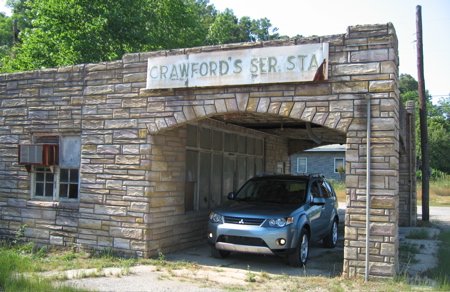
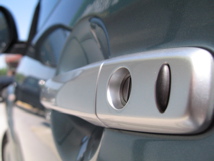 On the XLS model we had, keyless entry lets you leave the fob in your pocket or purse. Place your hand on either of the front door handles, and the car magically unlocks. A push of the small, rubber-covered button on the handle locks it. At first this option might seem a bit frivolous and gadgety, but the first time you have a sleeping baby in one arm and a grocery bag in the other, you'll be thankful for the expense. We just wish the rear door handles were touch-sensitive, as well. In the sleeping-baby scenario, you first must open a front door, then open the back – still easier than fishing for the keys, but the process could be a bit improved.
On the XLS model we had, keyless entry lets you leave the fob in your pocket or purse. Place your hand on either of the front door handles, and the car magically unlocks. A push of the small, rubber-covered button on the handle locks it. At first this option might seem a bit frivolous and gadgety, but the first time you have a sleeping baby in one arm and a grocery bag in the other, you'll be thankful for the expense. We just wish the rear door handles were touch-sensitive, as well. In the sleeping-baby scenario, you first must open a front door, then open the back – still easier than fishing for the keys, but the process could be a bit improved.
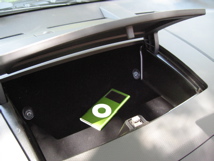 The Outlander's interior is both a strong and weak point, mixing near-luxury touches with cheapness. The soft leather seats were supportive and comfortable, but the dashboard, door panels and interior door handles felt cheap and flimsy. The small, shallow storage bin above the controls is a nice touch, but we wonder how long its plastic cover will hold up. In fact, our tester's was already warping a little, possibly due to the hot southern sun. Cupholders are lined with sound-deadening rubber, but it's permanently in place and can't be removed for easier cleaning. Overall, however, it's a nice looking place to spend a few miles. The black leather contrasts well with the metallic trim throughout the cabin. The wife and I agreed, however, it could have been a bit more matte. At some angles, the sunlight glinting off dash pieces on either side of the steering could almost blind the driver. Give the kids some sand paper, and it's no longer a problem.
The Outlander's interior is both a strong and weak point, mixing near-luxury touches with cheapness. The soft leather seats were supportive and comfortable, but the dashboard, door panels and interior door handles felt cheap and flimsy. The small, shallow storage bin above the controls is a nice touch, but we wonder how long its plastic cover will hold up. In fact, our tester's was already warping a little, possibly due to the hot southern sun. Cupholders are lined with sound-deadening rubber, but it's permanently in place and can't be removed for easier cleaning. Overall, however, it's a nice looking place to spend a few miles. The black leather contrasts well with the metallic trim throughout the cabin. The wife and I agreed, however, it could have been a bit more matte. At some angles, the sunlight glinting off dash pieces on either side of the steering could almost blind the driver. Give the kids some sand paper, and it's no longer a problem.
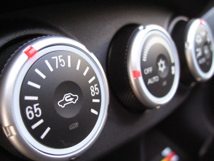 The driver scores a nice beefy, leather-wrapped steering wheel and two gorgeous metal paddle shifters to control the 6-speed Sportronic transmission. Audio and cruise control buttons are right there on the spokes, as is the Bluetooth handsfree button, which we'll get to in a bit. Maintenance information as well as odometer and mileage estimates are displayed on an LED screen between the speedo and tach, while the automatic climate-control worked as advertised.
The driver scores a nice beefy, leather-wrapped steering wheel and two gorgeous metal paddle shifters to control the 6-speed Sportronic transmission. Audio and cruise control buttons are right there on the spokes, as is the Bluetooth handsfree button, which we'll get to in a bit. Maintenance information as well as odometer and mileage estimates are displayed on an LED screen between the speedo and tach, while the automatic climate-control worked as advertised.
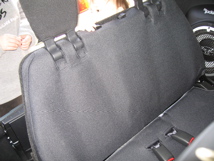
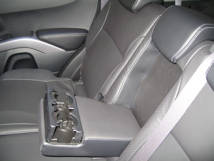


Back seat passengers get decent leg room, especially since front passengers may not need to push their chairs all the way back. Two up front and three in the back make five, but with the third-seat option, the Outlander could carry seven passengers. Just make sure you call dibs on the first five seats, because those two in the way back are best described as rudimentary. Through a six-step process, the mesh-covered metal frame springs from the rear cargo area ready to torture, uh, seat your most unlucky of passengers. It most closely resembles an Army surplus cot with headrests and seatbelts, but with less padding. It's not comfortable at all for adults and definitely not humane, but you have to admire the ingenuity. Get this option if you occasionally carry two extra small children, but skip it otherwise.
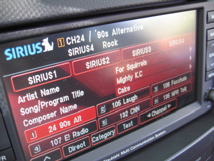
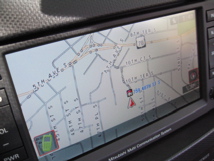 In-car gadgets can either be a help or a hindrance, but we found the Outlander's navigation system a big plus. It relies on a touch screen instead of a bunch of buttons and knobs, which makes its use much safer and easier. The same screen is used for the entertainment system as well as the car's security and lighting preferences.
In-car gadgets can either be a help or a hindrance, but we found the Outlander's navigation system a big plus. It relies on a touch screen instead of a bunch of buttons and knobs, which makes its use much safer and easier. The same screen is used for the entertainment system as well as the car's security and lighting preferences.
Satellite radio is standard on the XLS model and comes with six months of free service. Push a button and the touch-screen pivots up to reveal the CD slot. With the optional 30gb in-dash hard drive, just stick in a CD, and the car automatically adds all the tracks to your in-dash jukebox, complete with song titles. It's not a quick process, but it's usually done by the time the CD finishes playing. Use the touch screen to organize or delete tracks and leave your iPod in the house if you'd like. DVDs can also be played on the LCD screen. An auxiliary jack resides behind the touch screen next to the CD slot, but even if we had figured out how to get it to work, we're not sure how often we'd use it. Like we said, the only way to access the jack is to flip up the touch screen, which is also how you access the audio controls. With the jack exposed, the screen is facing straight up, and not visible to anyone – definitely not convenient.
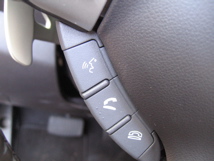 The handsfree Bluetooth option, on the other hand, was very simple to use. Turn your mobile phone's Bluetooth on, follow the manual's instructions and your car and phone are synced. To make a call, push the phone button on the left wheel spoke, and tell the car who you're calling. With no other conversations in the car, the voice recognition system works flawlessly. With a babbling 1-year-old in the back seat, you'll call several different area codes before reaching the right number. Your best bet is to wait until the young'uns fall asleep to make your calls.
The handsfree Bluetooth option, on the other hand, was very simple to use. Turn your mobile phone's Bluetooth on, follow the manual's instructions and your car and phone are synced. To make a call, push the phone button on the left wheel spoke, and tell the car who you're calling. With no other conversations in the car, the voice recognition system works flawlessly. With a babbling 1-year-old in the back seat, you'll call several different area codes before reaching the right number. Your best bet is to wait until the young'uns fall asleep to make your calls.
Putting that toddler in the back requires little effort. The child safety seat installed very easily in the center position using the LATCH system. Getting him in and out was easy too, thanks to the Outlander's wide rear-passenger opening and tall doors.


Cargo room is plentiful, with plenty of space left after accepting a stroller. Without the Fosgate sound system, the rear loses the metal-grated subwoofer and gains a little more space. Accessing the cargo area is also improved with the car's novel tailgate. After opening the upper rear hatch, release a latch on the lower part and a small tailgate drops down, which is great for sliding cargo out or for football tailgating.
Rear seat cupholders are recessed into the center armrest, which means with a child seat installed there, rear seat passengers will have to hold their drinks. It's a minor inconvenience, but one to consider. A taller friend of ours also complained that rear headroom was not to his liking.
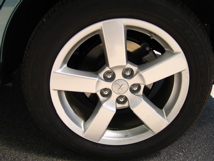
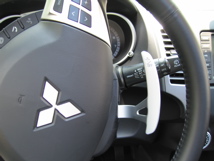
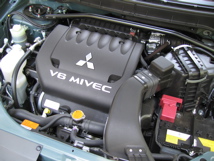
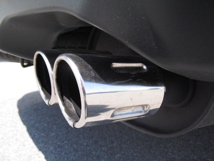
All Outlander models come with Mitsubishi's 3.0L V6 bolted to the automaker's Sportronic manumatic. Our tester also got the all-wheel-drive option, which made for a very sweet setup. In daily traffic, the SUV was smooth riding, smooth shifting, but ready to jump to immediate action if needed. Highway miles were nothing different. While many manumatics require the driver to first choose that mode with the center shifter before using, the the Sportronic only needs a bump of either paddle to drop from automatic to semi-manual. Holding the upshift paddle for a couple of seconds returns the car to fully automatic. At first we had only praise for this feature, as it really came in handy a couple of times when quick merges were called for. But then we discovered the downside. We know it's wrong, but occasionally, only for a second or two, we need both hands off the steering wheel. That means a moment of knee-driving, which, in the Outlander, kept triggering the manumatic mode. We admit, it could be what cures us of this bad habit, but it's pretty disconcerting to drop into fourth gear on the Interstate.
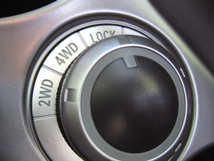 Mitsubishi also gives drivers choices with its all-wheel-drive system. A selector on the center console toggles between 2WD, automatic AWD and locked 4WD, where most of the power is sent to the rear wheels but the fronts also contribute some pull. To be honest, in normal driving, we didn't see much difference. My wife said if she had to choose, the 2WD option would be her preference. Supposedly the 2WD option gives better fuel economy in normal driving, but we didn't have the car long enough to really judge.
Mitsubishi also gives drivers choices with its all-wheel-drive system. A selector on the center console toggles between 2WD, automatic AWD and locked 4WD, where most of the power is sent to the rear wheels but the fronts also contribute some pull. To be honest, in normal driving, we didn't see much difference. My wife said if she had to choose, the 2WD option would be her preference. Supposedly the 2WD option gives better fuel economy in normal driving, but we didn't have the car long enough to really judge.
 We put 350 miles on our Outlander over a week's time, burning about 20 gallons of regular unleaded. Most of those were highway miles with the air conditioner running in the stifling southern heat. With my lead foot, we saw an average of about 18 mpg, just under the EPA's estimated 19 mpg. Not too bad, but not as good as estimates for the four-cylinder CR-V or even the V6 RAV-4.
We put 350 miles on our Outlander over a week's time, burning about 20 gallons of regular unleaded. Most of those were highway miles with the air conditioner running in the stifling southern heat. With my lead foot, we saw an average of about 18 mpg, just under the EPA's estimated 19 mpg. Not too bad, but not as good as estimates for the four-cylinder CR-V or even the V6 RAV-4.
Mitsubishi's 5-year/60,000 mile bumper-to-bumper and 10-year/100,000 mile powertrain warranties should cover any worries you might have about initial quality problems. It's difficult for us to comment on the Outlander's long-term reliability since it was just re-designed.
When all is said and done, we really liked the Outlander. Its attractive design, comfortable if somewhat cheap interior, cool gadgets and smooth ride combined with a fairly powerful and relatively economical engine to make it a candidate for any young family. If we can trim some of those more expensive options ($1,800 for nav, $1,500 for the Rockford Fosgate package), we can take our tester's sticker down from $30,615 to somewhere in the $28k range and closer to our budget. This family is adding it to its semi-finalists, and we suggest other family-car shoppers at least give it a look.

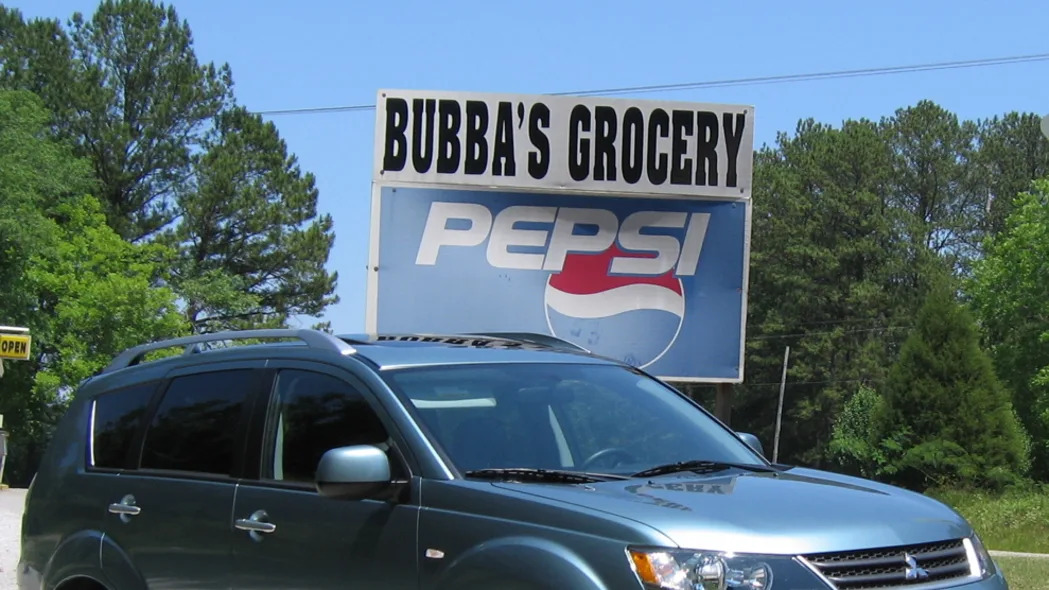

Sign in to post
Please sign in to leave a comment.
Continue